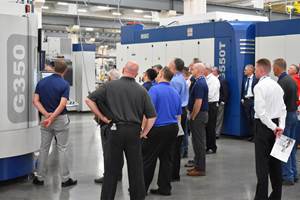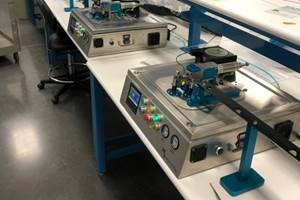The time could be ripe for U.S. shops to consider a technology that has already caught on in select overseas markets—devices that enable EDM users to quickly and automatically swap wire types and diameters. Benefits of the automatic wire changer (AWC) include faster cycles, reduced operating costs and longer unattended runs, says Ken Baeszler, product manager at GF AgieCharmilles (Lincolnshire, Illinois). He adds that this capability is especially useful for efficient wire EDM cutting of small internal radii.
Although the company has been developing this technology for nearly 10 years, previous versions of the AWC didn’t attract widespread attention in the United States. Mr. Baeszler argues that could change as the trend toward reshoring continues to renew domestic interest in work that benefits most from these devices: high-precision components for the tool and die, electronics and medical sectors. For U.S. shops, playing in this arena means competing with facilities in places like Germany, Japan, South Korea and Taiwan that are capable of churning out comparable-quality parts on equally sophisticated equipment.
These foreign shops have been taking advantage of automatic wire changing for years, and the relatively recent availability of GF Agie-Charmilles’ more-accessible, third-generation models can enable domestic manufacturers to do the same, Mr. Baeszler says. The AWC is available as an option for the company’s CUT 2000 and CUT 3000 wire EDMs, which are designed for high precision and stringent surface-finish requirements.
Automatic wire changes take less than two minutes, Mr. Baeszler says. Two spools at the back of the machine feed wire to two corresponding brake mechanisms at the front. After the first wire is cut, one brake mechanism rotates out of the way and the other rotates into place to enable automatic threading of the second wire from the other spool.
At the heart of the design is a proprietary wire-guide system that can accommodate wire ranging from 0.1 to 0.3 mm in diameter (0.03 to 0.07 mm is available as an option). Unlike conventional, toroid-shaped wire guides, the Universal V-Guide system resembles two opposed, pointed cones that form a “V” shape—or, as Mr. Baeszler describes it, “like two pencil points pushing against each other.” Rather than threading a specific wire size through a hole with a clearance of only a few microns, this design enables a range of wires to nestle snugly within this “V” shape. The current contact that charges the wire also serves to secure it within this “V” slot. During a change, the current contact moves out of the way to enable a new wire type or diameter to slide into place.
In the field, the most common application of the AWC system is using a larger-diameter wire wherever possible and switching to a smaller diameter for otherwise inaccessible part features, Mr. Baeszler says. This strategy can provide significant time savings for parts such as electronic connector stampings, which often feature small internal radii. Generally, the smaller the wire diameter, the slower the cut. Nonetheless, without automatic wire-change capability, most EDM users would likely opt to cut the whole part with a smaller-diameter wire because the time involved in swapping wires would preclude any benefit.
Another advantage is the ability to employ different types of wires for different operations. For example, a user might opt to rough a part with a faster, coated wire before trimming with a less-expensive brass wire. This can reduce operating costs and improve efficiency without compromising quality, Mr. Baeszler says.
Finally, the ability to accommodate a large amount of wire—the CUT 2000 offers two 55-pound spools—complements the inherent lights-out benefits of automatic wire-change capability by enabling longer unattended runs than comparable EDMs, Mr. Baeszler says. He adds that these longer runs are particularly useful for manufacturers that deal with large amounts of carbide, a material often used for electronic-industry punches and dies. That’s because the CUT 2000 EDM is available in an OilTech model that uses oil dielectric rather than water. “Water will start pitting the carbide after a while,” he explains. “With oil, you can stack the table up with carbide and not worry about corrosion. We’re not the only ones who offer oil dielectric, but we are the only ones who offer automatic wire-changing capability in conjunction with oil technology.”
To learn more about GF Machining Solutions LLC click here.

































